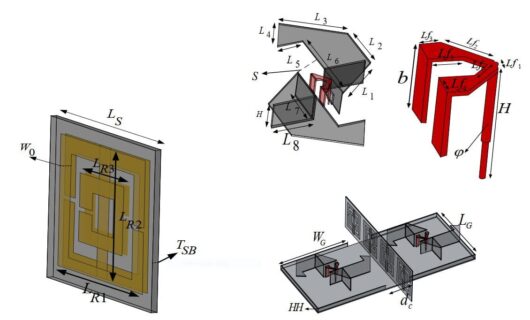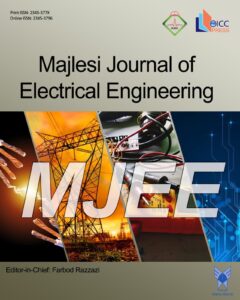Reduction of Mutual Coupling Between Two Circularly Polarized Magneto-Electric Dipole Antennas Using Metasurface Wall Polarization Converter for 5G Application
Authors
Abstract
The mutual coupling issue between two Right Hand Circularly Polarized (RHCP) Magneto-electric (ME) dipole antennas is addressed in this study. To mitigate this issue, a Metasurface Polarization-Rotator (MPR) Wall is employed, resulting in effective minimization of the coupling effects. The innovative antenna design, with high gain, shows promise for 5G applications. It consists of two electric dipole plates with triangular corners positioned at the top, along with two plates acting as magnetic dipoles perpendicular to the ground plane. Additionally, the presence of four plates on the outer periphery of the antenna contributes to the improvement of the circular polarization (CP) performance of the antenna. The feeding structure is configured in a V-shape. Integration of the metasurface polarization-rotator led to a significant reduction in mutual coupling. On average, the mutual coupling is decreased by more than -20.5 dB, reaching impressive values of -45 dB at 2 GHz, -55 dB at 3.1 GHz, and -40 dB at 3.7 GHz when the MPR wall is placed between the ME antennas. The antenna demonstrates promising performance in terms of impedance bandwidth, with a remarkable value of 61.4% for |S11| < [-10dB]. Furthermore, the axial ratio bandwidth for AR < [3 dB] is 63.36%, representing an 11% increase compared to the configuration without the MPR Wall. The maximum right-hand circular polarization gain achieved by the antenna is 9.91 dB at a frequency of 3 GHz. Additionally, the maximum front-to-back ratio (FBR) is 37.6 dB at a frequency of 2.5 GHz. By comparing and analyzing the simulation results for the scenarios with and without the MPR Wall, it becomes evident that the MPR Wall does not significantly affect the parameters of gain, front-to-back ratio, and impedance bandwidth.
Graphical Abstract
Keywords
- Mutual Coupling
- Magneto-Electric Dipole Antenna
- Wideband
- High Gain
- Metasurface Polarization -Rotator
References
[1] Ludwig, “Mutual coupling, gain and directivity of an array of two identical antennas,” IEEE Trans. Antennas Propag., Vol. AP-24, No. 6, pp. 837–841, Nov. 1976.
[2] K. S. Vishvaksenan, K. Mithra, R. Kalaiarasan and K. S. Raj, "Mutual Coupling Reduction in Microstrip Patch Antenna Arrays Using Parallel Coupled-Line Resonators," in IEEE Antennas and Wireless Propagation Letters, Vol. 16, pp.21462149, 2017.
[3] S. Kim and S. Nam, "A Compact and Wideband Linear Array Antenna With Low Mutual Coupling," in IEEE Transactions on Antennas and Propagation, Vol. 67, No. 8, pp.5695-5699, Aug. 2019.
[4] J Y. Lee, S. -H. Kim and J. -H. Jang, "Reduction of Mutual Coupling in Planar Multiple Antenna by Using 1-D EBG and SRR Structures," in IEEE Transactions on Antennas and Propagation, Vol. 63, No. 9, pp. 4194-4198, Sept. 2015.
[5] S. Ghosal, A. De, R. M. Shubair and A. Chakrabarty, "Analysis and Reduction of Mutual Coupling in a Microstrip Array With a Magneto-Electric Structure," in IEEE Transactions on Electromagnetic Compatibility, Vol. 63, No. 5, pp. 1376-1383, Oct.2021.
[6] H. M. Bernety and A. B. Yakovlev, "Reduction of Mutual Coupling Between Neighboring Strip Dipole Antennas Using Confocal Elliptical Metasurface Cloaks," in IEEE Transactions on Antennas and Propagation, Vol. 63, No. 4, pp. 1554-1563, April 2015.
[7] Tang et al., "A Metasurface Superstrate for Mutual Coupling Reduction of Large Antenna Arrays," in IEEE Access, Vol. 8, pp. 126859-126867, 2020.
[8] G. Moreno et al., "Wideband Elliptical Metasurface Cloaks in Printed Antenna Technology," in IEEE Transactions on Antennas and Propagation, Vol. 66, No. 7, pp.3512-3525, July 2018.
[9] H. Luan, C. Chen, W. Chen, L. Zhou, H. Zhang, and Z. Zhang, "Mutual Coupling Reduction of Closely E/H-Plane Coupled Antennas Through Metasurfaces," in IEEE Antennas and Wireless Propagation Letters, Vol. 18, No. 10, pp. 1996-2000, Oct. 2019.
[10] J. d. D. Ntawangaheza, L. Sun, Z. Xie, Y. Pang, Z. Zheng and G. Rushingabigwi, "A Single-Layer Low-Profile Broadband Metasurface Antenna Array for Sub-6 GHz 5G Communication Systems," in IEEE Transactions on Antennas and Propagation, Vol. 69, No. 4, pp. 2061-2071, April 2021.
[11] J. Lai, B. Feng, Q. Zeng, and K. L. Chung, "A substrate integrated magneto-electric dipole antenna using metasurface for 2G/3G/LTE/5G applications," 2017 Sixth Asia-Pacific Conference on Antennas and Propagation (APCAP), 2017.
[12] Y. -L. Li and K. -M. Luk, "Dual Circular Polarizations Generated by Self-Polarizing Fabry–Pérot Cavity Antenna With Loaded Polarizer," in IEEE Transactions on Antennas and Propagation, Vol. 69, No. 12, pp. 8890-8895, Dec. 2021.
[13] Le-Wei Li, Mook-Seng Leong, Pang-Shyan Kooi, Tat-Soon Yeo, and Kian-Hwa Tan, "Rectangular modes and dyadic Green's functions in a rectangular chiro waveguide. I. Theory," in IEEE Transactions on Microwave Theory and Techniques, Vol. 47, No. 1, pp.67-73, Jan. 1999.
[14] T. Limpiti, A. Chantaveerod, & W. Petchakit, Design of a Magneto-Electric Dipole Antenna for FM Radio Broadcasting Base Station Antenna Implementation. Progress In Electromagnetics Research M, 60, 75–84. 2017.
[15] Govindanarayanan, I., Rangaswamy, N. & Anbazhagan, R. "Design and analysis of broadband magneto-electric dipole antenna for LTE femtocell base stations,”. Journal of Computational Electronics 15, 200–209 2016.
[16] M. Li, & K.-M. Luk, Wideband Magneto-electric Dipole Antennas. In: Chen, Z. (eds) Handbook of Antenna Technologies. “Springer, Singapore, 2015.
[17] M. Farahani, J. Pourahmadazar, M. Akbari, M. Nedil, A. R. Sebak and T. A. Denidni, "Mutual Coupling Reduction in Millimeter-Wave MIMO Antenna Array Using a Metamaterial Polarization-Rotator Wall," in IEEE Antennas and Wireless Propagation Letters, Vol. 16, pp. 2324-2327, 2017.





